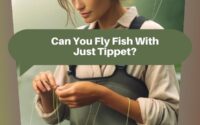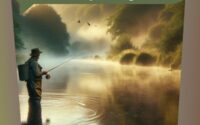| Disclosure: Just to be open and honest the buttons and links you click on in the website will in most cases take you to another website where you can purchase the products I am reviewing. As an Amazon Associate I earn from qualifying purchases. |
Can You Fly Fish For Carp? Exploring the Artistry
Quick Post Navigation
Introduction
Embarking on the journey of fly fishing for carp opens up a realm of excitement, challenge, and unparalleled connection with nature. Carp, renowned for their size, strength, and astute awareness, present a formidable adversary for anglers. While traditional methods of carp fishing have long prevailed, the allure of fly fishing for this species beckons with promises of adventure and skillful pursuit.
In the tranquil setting of serene waterways, anglers armed with fly rods and intricate patterns seek to unlock the secrets of enticing these elusive creatures. However, the question arises: Can you truly fly fish for carp? This inquiry delves beyond the surface, exploring the depths of technique, strategy, and the intimate dance between angler and quarry. Join us as we navigate the nuances of this captivating pursuit, unraveling the artistry and thrill of fly fishing for carp.
Understanding Carp Fishing
What is Carp Fishing?
Carp fishing involves targeting carp, a species of fish known for their large size, strength, and cunning behavior. Anglers typically use specialized equipment and bait to lure carp, often employing tactics such as bottom fishing or float fishing.
The Behavior of Carp
Carp are known for their cautious and selective feeding habits. They tend to be wary of unfamiliar objects and can quickly detect potential threats, making them a challenging catch for anglers.
Why Carp Fishing?
Carp fishing offers a unique challenge and rewards skilled anglers with the thrill of landing a prized catch. Additionally, carp are abundant in many waterways, providing ample opportunities for fishing enthusiasts.
Fly Fishing Techniques
Basics of Fly Fishing
Fly fishing is a distinct angling method that uses a lightweight artificial fly to mimic natural prey. Anglers cast the fly using a specialized fly rod, reel, and line, relying on the weight of the line to deliver the fly to the target.
Equipment Needed for Fly Fishing
To fly fish for carp, anglers require specific equipment tailored to the demands of this pursuit. This includes a sturdy fly rod capable of handling the size and strength of carp, as well as specialized flies designed to entice these wary fish.
Specific Techniques for Carp
Fly fishing for carp requires a different approach compared to traditional methods. Anglers often employ stealth tactics and precise presentation to entice carp to strike, relying on subtle movements and lifelike fly patterns.
Challenges and Considerations
Challenges of Fly Fishing for Carp
Fly fishing for carp presents its own set of challenges, including the need for patience, skill, and perseverance. Carp are highly sensitive to their environment and can be easily spooked, requiring anglers to approach with caution.
Location and Timing
Choosing the right location and timing is crucial for successful carp fly fishing. Carp are most active during certain times of the day and under specific weather conditions, requiring anglers to adapt their approach accordingly.
Understanding Carp Behavior
To effectively fly fish for carp, anglers must understand the behavior and feeding patterns of these fish. Carp often feed near the surface or along the bottom, making them susceptible to well-presented flies that mimic their natural prey.
Tips for Success
Patience is Key
Successful carp fly fishing requires patience and persistence. Carp can be selective in their feeding habits, requiring anglers to experiment with different flies and presentations until they find what works.
Choosing the Right Fly
Selecting the right fly is essential for enticing carp to strike. Anglers should choose flies that closely resemble the natural prey of carp, such as insects or small crustaceans, and vary their selection based on the conditions and preferences of the fish.
Presentation and Stealth
Effective presentation and stealth are critical for fooling wary carp. Anglers should approach quietly, making minimal disturbance to the water, and deliver their fly with precision to entice strikes from cautious fish.
Benefits of Carp Fly Fishing
Environmental Impact
Fly fishing for carp offers a more sustainable alternative to traditional methods, with minimal impact on the environment. Catch-and-release practices help preserve fish populations and ensure the long-term health of aquatic ecosystems.
Personal Satisfaction
Carp fly fishing provides anglers with a sense of accomplishment and satisfaction. Landing a carp on the fly requires skill, strategy, and perseverance, making each catch a rewarding experience for those who pursue this challenging pursuit.
Conclusion
In the tapestry of angling pursuits, fly fishing for carp emerges as a vibrant thread, weaving together passion, skill, and reverence for nature. As the sun sets on a day spent in pursuit of these majestic fish, anglers find solace in the rhythm of the cast, the whisper of the wind, and the pulse of anticipation that courses through their veins.
Through patience, perseverance, and a touch of finesse, anglers unlock the secrets of successful carp fly fishing, forging a bond with the water and its inhabitants that transcends mere sport. With each catch, a story unfolds—a testament to the symbiotic relationship between angler and quarry, and a celebration of the beauty that lies beneath the surface.
So, can you fly fish for carp? Indeed, the answer resonates not only in the affirmative but also in the myriad experiences, lessons learned, and memories created along the way. As the journey continues, may anglers find solace in the simplicity of a well-tied fly, the dance of shadows on the water, and the timeless pursuit of the next cast.
FAQs
Q) Can you use traditional bait for fly fishing for carp?
A) While traditional bait can be effective for carp fishing, fly fishing relies on artificial flies to mimic natural prey and entice strikes from wary fish.
Q) What type of waterways are ideal for fly fishing for carp?
A) Carp can be found in a variety of freshwater habitats, including lakes, rivers, and ponds. Look for areas with clear water and abundant aquatic vegetation.
Q) How do you know if a carp is feeding on the surface?
A) Watch for signs of feeding activity, such as bubbles, surface disturbances, or the sight of carp actively feeding near the water’s surface.
Q) What is the best time of day to fly fish for carp?
A) Carp are most active during the early morning and late evening hours when water temperatures are cooler. However, they can be caught throughout the day with the right tactics.
Q) Is catch-and-release important when fly fishing for carp?
A) Catch-and-release practices help preserve carp populations and ensure the sustainability of fisheries for future generations of anglers.



